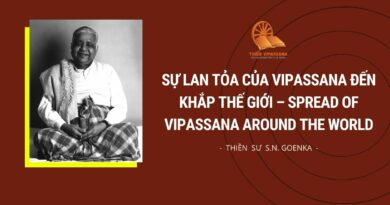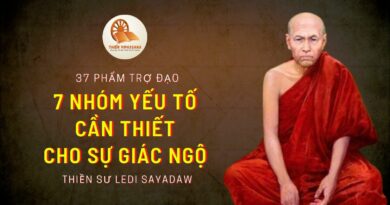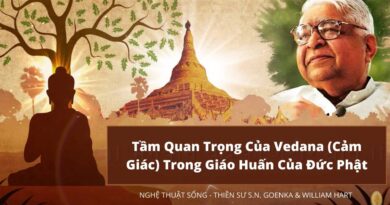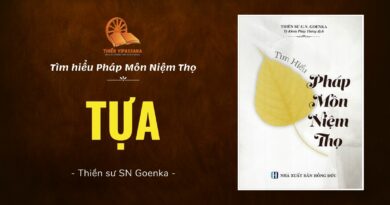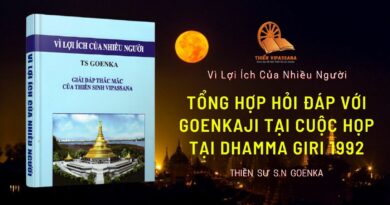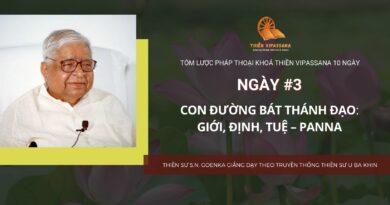Pháp thoại về Đức Phật- Có phải Đức Phật là một người bi quan?
(The following is an extract from a book ‘ Was the Buddha a Pessimist?’ published by VRI. It is the translation and adaptation of Kya Buddha Dukkhavadi The? The VRI Hindi publication by S. N. Goenka.)
(Bài sau đây được trích từ một cuốn sách ‘Đức Phật có phải là người bi quan?’ ấn hành bởi VRI. Bản dịch và trích lược của cuốn Kya Buddha Dukkhavadi The? Do thầy S.N.Goenka trình bày được VRI ấn bản bằng tiếng Hindi.
I remember that during my youth, a missionary had come from India to Mandalay. In one of his discourses, he said, The Buddha only taught four things-suffering, the cause of suffering, the eradication of suffering and the path of the eradication of suffering. All he is talking about is suffering! There is no happiness anywhere. There is not a trace of happiness in the Buddha’s teaching. He is a pessimist! The Buddha taught nothing but pessimism. To use the word Noble (arya) for this teaching is wrong. How can suffering be noble? Truth, bliss and absorption are called arya. In the Buddha’s teaching none of these are present!
Tôi nhớ lại vào thời trai trẻ, một nhà truyền giáo từ Ấn Độ đã đến Mandalay. Trong một bài pháp thoại, ông nói, Đức Phật chỉ dạy bốn điều- khổ, nguyên nhân của khổ, diệt trừ khổ và con đường để diệt khổ. Tất cả những điều ngài nói là về khổ! Không có hạnh phúc ở đâu cả. Không có dấu vết của hạnh phúc trong lời dạy của Đức Phật. Ngài là một người bi quan! Đức Phật không dạy gì ngoài bi quan. Để dùng từ Cao Quý (arya) cho lời dạy như thế là sai lầm. Làm thế nào khổ lại cao quý? Sự thật, phúc lạc và sự hòa hợp được gọi là cao quý arya. Trong lời Đức Phật dạy không có những điều này!
This missionary was a powerful speaker. Being only a teenager I was quite immature, and his speech impressed me. I found his point quite logical: The Buddha’s teaching is full of suffering and totally devoid of happiness.
Nhà truyền giáo này là một diễn giả tài năng. Khi chỉ là một cậu thiếu niên tôi khá non nớt, và lời nói của ông ta làm tôi ấn tượng. Tôi thấy quan điểm của ông khá hợp lý: Lời dạy của Đức phật toàn về khổ và hoàn toàn không có hạnh phúc.
Years later when I realised for myself the true meaning of the four Noble Truths, I became ashamed of my lack of wisdom in my teenage years. While these four Noble Truths of life were expounded in systematic detail by the Buddha, only Vipassana helped me to understand them.
Những năm sau tôi tự mình nhận ra ý nghĩa thực sự của Bốn sự Thật Cao Quý, tôi trở nên xấu hổ vì sự thiếu trí tuệ của mình trong thời niên thiếu. Trong khi bốn sự Thật Cao Quý này của đời sống đã được giải thích một cách chi tiết hệ thống bởi Đức Phật, chỉ có Vipassana mới giúp tôi hiểu chúng.
Suffering is one truth of life. It arises because of craving and aversion, which in turn arise from tanhā (trsna). If these causes are eradicated, then the root cause of suffering is eradicated. For this, there is a practical technique, a path, a way: an Eightfold Path, which teaches one, while living a moral and upright life, to master one’s mind and to develop paññā (experiential wisdom).
Khổ là một sự thật của cuộc đời. Nó khởi lên do tham ái và oán ghét, điều bắt đầu sinh ra từ tanhā (trsna). Nếu những nguyên nhân này bị diệt trừ, thì nguyên nhân gốc rễ của khổ bị diệt trừ. Vì lẽ này, có một kỹ thuật, một con đường, phương cách thực tiễn: Con đường Tám nhánh, con đường dạy một người, sống một cuộc đời đạo đức và hướng thượng, để làm chủ tâm và phát triển paññā (tuệ kinh nghiệm).
If one practices paññā (prajna), then new impurities do not arise in the mind and the old stock of impurities is automatically eradicated. After all, what is the eradication of suffering? It is a direct result of purifying the mind, the experience of nibbāna (nirvana). Suffering, its cause, its eradication and the path of its eradication are called Noble Truths of suffering. The final aim of the teaching of the Buddha is to eradicate all suffering.
Nếu một người thực hành paññā (prajna), thì bất tịnh mới không khởi lên trong tâm và hàng đống bất tịnh cũ sẽ tự động diệt đi. Sau cùng, cái gì được gọi là diệt khổ? Đó là kết quả trực tiếp của việc thanh lọc tâm, kinh nghiệm về niết bàn (nirvana). Khổ, nguyên nhân của khổ, cách diệt khổ và con đường diệt khổ gọi là Bốn sự thật cao quý về khổ. Mục đích cuối cùng của lời dạy của Đức Phật là diệt tất cả đau khổ.
The Noble Truth of the eradication of suffering is explained in four aspects:
Sự Thật Cao Quý về diệt khổ được giải thích ở bốn khía cạnh:
Nissaranatthā: To come out of all the accumulated impurities (defilements)
Nissaranatthā: Thoát khỏi mọi bất tịnh tích lũy (ô nhiễm)
Vivekatthā: To be free from the habit of developing new impurities
Vivekatthā: Giải thoát khỏi thói quen tạo ra các bất tịnh mới.
Asankhatattha: To experience for oneself the unborn state where nothing arises
Asankhatattha:Tự kinh nghiệm trạng thái không sinh ra nơi không có gì khởi lên
Amatatthā: To experience for oneself the deathless state where nothing passes away.
Amatatthā: Tự kinh nghiệm trạng thái bất tử nơi không có gì diệt đi.
It became clear to me through the practice of Vipassana that misery arises the moment the mind is defiled with craving or aversion. And misery passes away when the defilements are removed. As many defilements are removed, that much misery is eliminated. If all the past-accumulated impurities are eradicated and the habit of making new impurities is broken, then misery is totally eradicated – dukkhā-nirodhā.
Điều này rất rõ ràng với tôi thông qua thực hành Vipassana đau khổ sinh ra trong khoảnh khắc tâm lấp đầy tham ái hoặc oán ghét. Và đau khổ diệt đi khi bất tịnh bị tiêu trừ. Càng nhiều bất tịnh bị diệt đi, càng nhiều đau khổ bị loại bỏ. Nếu tất cả các bất tịnh tích lũy trong quá khứ bị diệt đi và thói quen tạo ra các bất tịnh mới bị phá vỡ, thì khổ đau toàn toàn diệt đi-dukkhā-nirodhā.
In today’s India, nirodhā is used to denote suppression. However, when something is suppressed, it may again raise its head at any time in the future. In contrast, the original meaning of nirodhā is complete uprooting, total eradication. That which cannot arise again is nirodhā. Therefore dukkhā-nirodhā means that dukkhā (suffering) cannot arise again.
Tại Ấn Độ ngày nay, từ nirodhā dùng để chỉ triệt tiêu. Tuy nhiên, khi mọi thứ bị triệt tiêu, nó có thể lại sinh ra như cũ ở bất kỳ lúc nào trong tương lai. Trái lại, nguyên bản của từ nirodhā là hoàn toàn cắt đứt gốc rễ, hoàn toàn diệt trừ. Không thể tái sinh lại là nirodhā. Do vậy dukkhā-nirodhā có nghĩa là dukkhā (khổ) không thể sinh ra nữa.
This was explained using the example of a palm tree. When a palm tree’s top is cut off, the tree does not get new leaves; it dies. Similarly, the path of total eradication of misery is taught in the fourth Noble Truth. Misery cannot arise again. This was called –
Điều này được giải thích bằng ví dụ một cây cọ. Khi ngọn của cây cọ bị cắt đi, cây không thể có lá mới; nó chết đi. Tương tự vậy, con đường diệt khổ được dạy trong Bốn Sự Thật Cao Quý. Khổ không thể sinh ra lần nữa. Đó được gọi là-
Pahīno, ucchinnamūlo, tālāvatthukato, anabhāvaṃkato, āyatim anuppādadhammo
-destroyed, uprooted, like a palm tree whose head is cut off, extinguished, attaining the state of non-arising.
– phá hủy, cắt gốc rễ, như ngọn cây cọ bị cắt đi, bị dập tan, đạt trạng thái không sinh ra.
Similarly, today arya merely denotes a caste or race. However, in the days of the Buddha, arya denoted not simply caste or race but, rather, qualities. If a person of any race, caste or class-walking on the path of the Dhamma (Universal Law) by the development of morality, mastery over the mind and experiential wisdom-attained the first of the four stages of liberation, he was called an Arya (a Noble One).
Tương tự, ngày nay arya đơn thuần chỉ một đẳng cấp hoặc một chủng tộc. Tuy nhiên, trong những ngày đó vào thời Đức Phật, arya không chỉ đơn thuần chỉ đẳng cấp hay chủng tộc mà, còn, chỉ phẩm tính. Nếu một người thuộc bất kỳ chủng tộc, đẳng cấp hoặc địa vị nào- bước trên con đường của Dhamma (Luật Tự Nhiên) bằng việc phát triển đạo đức, sự làm chủ tâm và tuệ kinh nghiệm-đạt được giai đoạn đầu tiên của bốn giai đoạn giải thoát, anh ta được gọi là một Arya (Một người Cao quý)
This stage is called sotāpannā (stream-enterer)-that is, this person has entered the stream of complete liberation from the cycle of birth and death. Such a person is partially liberated. One is totally freed from the possibility of future lives in the lower worlds because of eradication of all kammas (karmas) that would take one to such lower worlds even though one still has some kammas left, which may result in a maximum of seven lives before final liberation from all rebirth. Hence, such a person is entitled to the epithet of arya.
Giai đoạn này được gọi tu đà hoàn (người nhập dòng)-là, người này vừa bước nào dòng chảy của giải thoát hoàn toàn khỏi vòng sinh tử luân hồi. Một người như thế được giải thoát một phần. Một người giải thoát hoàn toàn thoát khỏi khả năng sinh vào đời sống tương lai ở cõi giới thấp vì anh ta đã tiêu trừ hết nghiệp (karmas) và một người sẽ bị dẫn đến cõi giới thấp hơn thậm chí khi anh ta vẫn còn vài nghiệp, điều này có thể đạt tối đa trong bảy kiếp trước khi giải thoát hoàn toàn khỏi tái sinh. Do vậy, một người như vậy được xưng là arya.
Continuing the practice of Vipassana, the practitioner successively becomes a sakadāgāmī (once-returner), anāgāmī (non-returner) and finally attains the state of an arahat (fully liberated being). Thus, arya-satya (Noble Truth) is a truth through the experience of which anyone can become an arya – noble person.
Tiếp tục thực hành Vipassana, hành giả thành công trở thành một sakadāgāmī (người trở lại lần nữa), anāgāmī (người không trở lại) và cuối cùng đạt trạng thái của a la hán (người hoàn toàn giải thoát). Do vậy, arya-satya (Sự thật Cao Quý) là sự thật thông qua kinh nghiệm của nó bất kỳ ai cũng có thể trở thành một arya- người cao quý.
Linguistic Derivations/ Trích dẫn Ngôn Ngữ
The language of the Vedas was called Chandas at the time of the Buddha. About two centuries after the Buddha, an erudite grammarian by the name of Panini wrote a new grammar and thus created a new language based on the existing language, but quite different from it. It was governed by new rules. The language that was created was called Sanskrit (literally: composed, created, fashioned or artificial).
Ngôn ngữ của Vệ Đà được gọi là Chandas vào thời Đức Phật. Khoảng hai thế kỷ sau thời Đức Phật, một nhà ngữ pháp học uyên bác tên Panini viết một ngữ pháp mới và do đó tạo ra một ngôn ngữ dựa trên ngôn ngữ hiện thời, nhưng khá khác. Nó được ban hành bởi luật mới. Ngôn ngữ được tạo ra là tiếng Sanskrit (có nghĩa: được sáng tác, tạo ra, thời thượng hoặc nhân tạo).
Arya was used in the Vedic literature at the time of the Buddha in the qualitative sense, as well as to denote caste. In the literature of Panini’s Sanskrit also, both meanings were applied to arya. Later on a new meaning was added: the people of the three classes (namely, Brahmins, Kshatriyas and Vaishyas) were called arya.
Arya được dùng trong kinh điển Vệ Đà vào thời Đức Phật theo nghĩa phẩm tính, cũng như chỉ đẳng cấp. Trong kinh điển của tiếng Sanskrit của Panini cũng vậy, hai nghĩa trên cũng được áp dụng cho arya. Sau đó một nghĩa mới được thêm vào chỉ: con người của ba tầng lớp (tên là, Bà La Môn, Kshatriyas và Vaishyas) được gọi là arya.
The Buddha gave his discourses in his mother tongue, which was Kosali. This was the spoken language of the kingdom of Kosala and it was the natural language spoken by the people. It was not an artificially created language like Sanskrit. This Prakrit (literally, natural’) language protected the words of the Buddha for centuries, therefore it was called Pāli (that which protects’).
Đức Phật thuyết pháp bằng tiếng mẹ để, là Kosali. Ngôn ngữ này là tiếng nói của vương quốc Kosala và là ngôn ngữ tự nhiên của mọi người. Không phải là ngôn ngữ nhân tạo như tiếng Sanskrit. Đây là ngôn ngữ Prakrit (có nghĩa tự nhiên) đã bảo vệ lời nói của Đức Phật trong nhiều thế kỷ, do vậy được gọi là tiếng Pāli (có nghĩa là bảo vệ’).
Years after the Buddha, the entire region of northern India along with the state of Kosala came under the rule of the Magadha Emperor Ashoka, who adopted not only the teaching of the Buddha but also his language. Then the language started to be called Magadhi. In this language, arya is ariyā, an epithet for all those who have attained stages from sotāpannā to arahat.
Những năm sau thời Đức Phật, toàn bộ lãnh thổ Bắc Ấn dọc theo vùng Kosala đặt dưới sự vị trì của Hoàng Đế Magadha Ashoka, người không chỉ chấp nhận lời dạy của Đức Phật mà còn ngôn ngữ của ngài. Khi đó ngôn ngữ này bắt đầu gọi là Magadhi. Trong ngôn ngữ này, arya là ariyā, là danh xưng cho tất cả ai đạt giai đoạn từ tu đà hoàn đến a la hán.
In the Buddha’s teaching in the vast Pāli literature, ariyā (arya) never once denoted caste or race. It always referred to qualities. For example:
Trong lời dạy Đức Phật trong toàn thể kinh điên Pali, ariyā (arya) chưa lần nào là chỉ đẳng cấp hay chủng tộc. Từ này chỉ phẩm tính. Ví dụ:
Visuddho uttamoti ariyo – one who is pure and supreme is an arya.
Visuddho uttamoti ariyo – người thanh tịnh và siêu việt là một arya.
Ariyoti kilesehi ārakā thito parisuddho – one who is far away from the stains of passion, and thus, supremely pure, is an arya.
Ariyoti kilesehi ārakā thito parisuddho -người rời xa vết ố của đam mê, và thanh tịnh siêu việt, là một arya.
Anaye na iriyatīti ariyo – one who does not follow the unwholesome way is an arya.
Anaye na iriyatīti ariyo – người không theo con đường bất thiện là một arya.
Ahimsā sabbapānānam ariyoti pavuccatī – One who is non-violent towards all beings is an arya.
Ahimsā sabbapānānam ariyoti pavuccatī – người không bạo lực với ai là một arya.
Ariyaphalapatilābhato ariyoti – One who has attained nibbana is an ārya.
Ariyaphalapatilābhato ariyoti -Người đạt được niết bàn là một arya.
In contrast, those who are far away from the fruit of arya (nibbāna) are called puthujjanā. It is said
Trái lại, người xa rời khỏi quả của arya (niết bàn) được gọi là puthujjanā. Điều này được gọi là:
Hīno gammo pothujjaniko anariyo anatthasaṃhito –
a non-arya (anariyā) is one who is base, uninitiated (rustic), far away from nibbāna and collects unwholesome states.
Hīno gammo pothujjaniko anariyo anatthasaṃhito – một người không phải arya (anariyā) là một người thấp kém, không thông thạo (ngờ nghệch), xa rời niết bàn và chỉ nhận lãnh trạng thái bất thiện.
Ariyoti puthujjanabhūmi atikkanto – an arya is one who has crossed the field of puthujjanā (an ordinary worldly person).
Ariyoti puthujjanabhūmi atikkanto – một arya là người vượt qua lĩnh vực của một puthujjanā (một người thế gian bình thường).
The Noble Truths (ariyasaccāni) are similarly defined:
Sự Thật cao Quý (ariyasaccāni) cũng được định nghĩa tương tự:
Ariyā imāni pativijjhanti, tasmā ariyasaccānīti vuccantī – those truths that are known to the ārya are ārya truths (Noble Truths).
Ariyā imāni pativijjhanti, tasmā ariyasaccānīti vuccantī – những sự thật cao quý được biết là ārya và sự thật ārya (Sự Thật Cao Quý)
The Ultimate Truth/ Sự Thật Tối Thượng
Siddhattha Gotama (Siddhartha Gautama) attained the ultimate self-enlightenment in Bodh Gaya and became a perfectly Self-enlightened One.
Siddhattha Gotama (Siddhartha Gautama) tự mình chứng ngộ sự thật tối thượng ở Bodh Gaya và trở thành Bậc Giác Ngộ Tự Chứng Đắc.
Later, he taught the Dhamma to the five Brahmin ascetics from Kapilavatthu in Varanasi. In his first discourse he expounded the practical aspect of the four Noble Truths. There he explained how the four Noble Truths lead to the ultimate reality of nibbāna, which is beyond the senses: eternal, everlasting and permanent. He clarified how the four Noble Truths if practiced in all three aspects (in the complete twelve-fold manner) can lead to the experience of the ultimate reality.
Sau đó, ngài dạy Dhamma cho năm hành giả khổ hạnh Bà La Môn từ Kapilavatthu ở Varanasi. Trong bài pháp thoại đầu tiên ngài giải thích khía cạnh thực tế của Bốn Sự Thật Cao Quý. Ở đó ngài giải thích cách Bốn Sự Thật Cao Quý dẫn đến sự thật của niết bàn, điều vượt ra ngoài nhận biết: vĩnh cửu, thường hằng và bất biến. Ngài làm rõ cách Bốn sự thật cao quý nếu được thực hành trong cả ba phương diện (theo mười hai phương tiện) có thể dẫn đến kinh nghiệm về sự thật tối thượng.
According to the Buddha’s teaching, all four Noble Truths are also included in any one Noble Truth. Anyone who goes beyond misery does so by understanding the entire field of misery. Thus, the Noble Truth of suffering includes the other three.
Theo lời dạy của Đức Phật, tất cả bốn Sự thật Cao Quý cũng nằm trong một Sự Thật Cao Quý. Bất kỳ ai cũng có thể vượt khỏi khổ bằng việc hiểu toàn bộ lĩnh vực của khổ. Do vậy, Sự thật cao Quý của khổ gồm ba sự thật còn lại.
Within a week, all the five Brahmin ascetics attained complete liberation by practicing this benevolent teaching. Thus, they became the first five arahats after the Buddha. Vipassana proved fruitful!
Trong một tuần, tất cả năm nhà khổ hạnh Bà La Môn đạt được giải thoát hoàn toàn qua việc thực hành lời dạy lợi lạc này. Do vậy, họ trở thành năm vị a la hán sau Đức Phật. Vipassana đã chứng minh được lợi lạc!
From then on the Buddha wandered from the eastern border of Rajasthan to the western border of Bengal, ceaselessly serving people. He taught how to realize these Noble Truths through the practice of Vipassana, resulting in the experience of the eternal truth of nibbāna. Even in his lifetime, thousands of monks and nuns (bhikkhus and bhikkhunis) became arahats.
Từ sau đó Đức Phật đi khắp nơi từ bờ đông thành Rajasthan đến bờ tây Bengal, liên tục phục vụ đại chúng. Ngài đã dạy cách nhận biết những Sự Thật Cao Quý này thông qua thực hành Vipassana, kết quả kinh nghiệm sự thật vĩnh hằng của niết bàn. Thậm chí vào thời ngài, hàng ngàn tỳ kheo và tỳ kheo ni (bhikkhus and bhikkhunis) trở thành a la hán.
In addition, hundreds of thousands of both bhikkhus and householders had the first experience of the ultimate reality when they became sotāpannā (stream-enterer). Later, many became sakadāgāmī and anāgāmī. This technique of Vipassana benefited millions of people by liberating them from suffering in this very life through the realization of the four Noble Truths.
Hơn thế, hàng trăm ngàn người tỳ kheo và cư sĩ đã lần đầu kinh nghiệm được thực tế tối thượng khi họ trở thành tu đà hoàn (người nhập dòng). Sau đó, nhiều người đã trở thành sakadāgāmī and anāgāmī. Kỹ thuật này của Vipassana đã mang lại lợi lạc cho con người bằng việc giải thoát họ khỏi đau khổ trong cuộc đời chóng vánh thông qua nhận biết về Bốn sự thật Cao Quý
It was our misfortune that we lost this wonderful technique and all its literature from our country and as a result were deprived of its limitless benefit. Both the practice and the literature disappeared. With the teaching no longer available, people began to criticise it out of ignorance, declaring that they did not accept the noble truth of suffering. In the face of such an unfortunate historical development, how can one blame the Buddha or the Vipassana that he taught, for the currently accepted misconceptions about his teachings?
Nguồn Viện Nghiên Cứu Vipassana VRIDhamma.org


